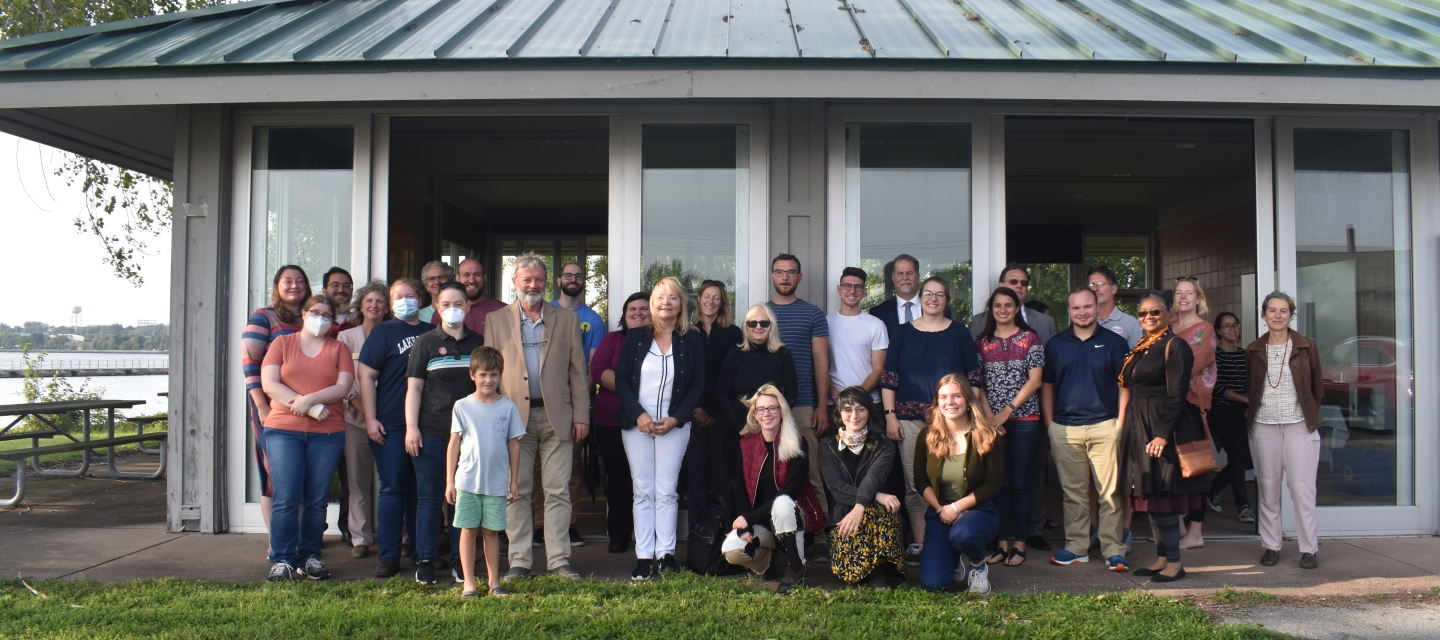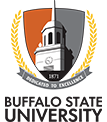
GLC staff and guests at the Annual Open House.
Mission
The Great Lakes Center's mission is to improve the quality of the environment by providing the best possible science to decision-makers concerned with the health and sustainability of resources, with a primary focus within the Great Lakes and their watersheds. This is accomplished through high quality research, informed and current graduate and undergraduate education, and dissemination of information to the public through outreach.
The center is committed to improving human-environment interactions in the Great Lakes ecosystem guided, in part, by an understanding of the evolutionary and ecological processes and patterns acting on the system.
Although the main focus of the research in the Great Lakes Center concentrates on the Great Lakes basin, national and international projects are also considered of high priority as they expose our scientists to the cutting edge of modern science, facilitate collaboration, and greatly increase visibility to the center's activity in the scientific community.
Meet our faculty and staff
Collaboration
- Kelly Frothingham, Dean, School of Arts and Sciences
- Susan McCartney, Director, Small Business Development Center
- Olga Novikova, Assistant Professor, Biology Department
- Mary Perrelli, GIS Lab Supervisor, Geosciences Department
- Daniel L. Potts, Professor, Biology Department
- Randal Snyder, Professor, Biology Department
- Tao Tang, Professor, Geosciences Department
- Stephen Vermette, Professor, Geosciences Department
- Robert J. Warren II, Professor, Biology Department
- Richard Barbiero, Chicago, Illinois
- Vadim Karatayev, Assistant Professor, University of Maryland College Park, Maryland
- Knut Mehler, Research Scientist, Helmholtz Centre for Polar and Marine Research, Alfred Wegener Institute, Germany
- Connie Adams, NYS Department of Environmental Conservation
- Gregory Boyer, SUNY Environmental Science and Forestry, Syracuse
- Mike Goehle, U.S. Fish and Wildlife Service
- Dmitry Gorsky, U.S. Fish and Wildlife Service
- Thomas Hahn
- Andrew Hannes, U.S. Army Corps of Engineers
- Kristen Holeck, Cornell Biological Field Station, Cornell University
- Dianna Padilla, Department of Ecology and Evolution, Stony Brook University
- Isabel Porto Hannes, University at Buffalo
- Erin Redding, NYS Department of Environmental Conservation
- Lars Rudstam, College of Agriculture and Life Sciences, Department of Natural Resources, Cornell Biological Field Station, Cornell University
- James Watkins, Cornell Biological Field Station, Cornell University
- Brian Weidel, U.S. Geological Survey, Lake Ontario Biological Station, Oswego
- Theodore Angradi, U.S. EPA Mid-Continent Ecological Division, Duluth, Minnesota
- Jakob Boehler, National Center for Water Quality Research, Heidelberg University, Tiffin, Ohio
- David Bunnell, U.S. Geological Survey, Great Lakes Science Center, Ann Arbor, Michigan
- Paris Collingsworth, Illinois-Indiana Sea Grant and Department of Forestry and Natural Resources, Purdue University, West Lafayette, Indiana
- Peter Esselman, U.S. Geological Survey, Great Lakes Science Center, Ann Arbor, Michigan
- Elizabeth Hinchey Malloy, U.S. EPA Great Lakes National Program Office, Chicago, Illinois
- Joel Hoffman, U.S. EPA, National Health and Environmental Effects Research Laboratory, Mid-Continent Ecology Division, Duluth, Minnesota
- Leon Katona, U.S. Geological Survey, Upper Midwest Water Science Center, Madison, Wisconsin
- Katya Kovalenko, Natural Resources Research Institute, University of Minnesota Duluth, Duluth, Minnesota
- Richard Kraus, U.S. Geological Survey, Lake Erie Biological Station, Huron, Ohio
- Barry Lesht, Department of Earth and Environmental Sciences, University of Illinois at Chicago; CSRA, Chicago, Illinois
- Julie Lietz, General Dynamics Information Technology, Falls Church, Virginia
- Charles Madenjian, U.S. Geological Survey, Great Lakes Science Center, Ann Arbor, Michigan
- Janet Nestlerode, U.S. EPA, National Health and Environmental Effects Research Laboratory, Gulf Ecology Division, Gulf Breeze, Florida
- Jessica Plavicki, Department of Pathology and Laboratory Medicine, Brown University, Providence, Rhode Island
- Euan Reavie, Natural Resources Research Institute, University of Minnesota Duluth, Duluth, Minnesota
- Mark Rowe, Great Lakes Environmental Research Laboratory, NOAA, Ann Arbor, Michigan
- Ed Rutherford, Great Lakes Environmental Research Laboratory, NOAA, Ann Arbor, Michigan
- Mike Sayers, Michigan Technological Research Institute, MTU, Ann Arbor, Michigan
- Anne Scofield, U.S. EPA Great Lakes National Program Office, Chicago, Illinois
- Robert Shuchman, Michigan Technological Research Institute, MTU, Ann Arbor, Michigan
- Anett Trebitz, U.S. EPA Office of Research & Development, Mid-Continent Ecology Division, Duluth, Minnesota
- Yvonne Vadeboncoeur, Department of Biological Sciences, Wright State University, Dayton, Ohio
- Jake Vander Zanden, Center for Limnology, University of Wisconsin-Madison, Madison, Wisconsin
- Daelyn Woolnough, Biology Department, Institute for Great Lakes Research, Central Michigan University, Mount Pleasant, Michigan
- David Zanatta, Biology Department, Institute for Great Lakes Research, Central Michigan University, Mount Pleasant, Michigan
- Boris Adamovich, Research Laboratory of Aquatic Ecology, Belarusian State University, Minsk, Belarus
- Csilla Balogh, Balaton Limnological Research Institute, Hungary
- Yulia Bespalaja, Federal Center for Integrated Arctic Research, Russian Academy of Sciences, Arkhangelsk, Russia
- Ivan Bolotov, Federal Center for Integrated Arctic Research, Russian Academy of Sciences, Arkhangelsk, Russia
- Demetrio Boltovskoy, University of Buenos Aires, Argentina
- Frank Collas, Radboud University, Nijmegen, the Netherlands
- Nancy Correra, Sede Educativa Universitaria, UNDEF, Buenos Aires, Argentina
- Ronald Dermott, Alumnus, Fisheries and Oceans Canada, Burlington, Canada
- Maria Dittrich, University of Toronto Scarborough, Toronto, Canada
- Elsa Froufe, CIIMAR - Interdisciplinary Centre of Marine and Environmental Research, University of Porto, Porto, Portugal
- Jürgen Geist, Fish Biology, TU München, Munich, Germany
- Ron Griffiths, Aquatic Ecostudies Limited, Canada
- Linda Haltiner, Kanton Luzern, Switzerland
- Jörg Huwyler, Department of Pharmaceutical Sciences, University of Basel, Switzerland
- Bastiaan Ibelings, University of Geneva, Geneva, Switzerland
- Benjamin Kraemer, University of Freiburg, Freiburg, Germany
- Manuel Lopes-Lima, CIBIO/InBIO - Research Center in Biodiversity and Genetic Resources, University of Porto, Porto, Portugal
- Frances Lucy, Institute of Technology Sligo, Sligo, Ireland
- Oleg Makarevich, Belarusian State University, Minsk, Belarus
- Tamara Makarevich, Belarusian State University, Minsk, Belarus
- Nicoletta Ricciardi, CNR-Institute of Water Research, Verbania Pallanza, Italy
- Zoltán Serfőző, Balaton Limnological Research Institute, Hungary
- Konstantin Shumskii, Department of Ichthyology and Aquaculture, Belarusian State Agricultural Academy, Belarus
- Ronaldo Sousa, CIIMAR and Minho University, Braga, Portugal
- Piet Spaak, EAWAG, Dübendorf, Switzerland
- Maria Urbańska, Poznań University of Life Sciences, Poznań, Poland
- Ilya Vikhrev, Federal Center for Integrated Arctic Research, Russian Academy of Sciences, and Northern (Arctic) Federal University, Arkhangelsk, Russia
- Alexandra Weber, EAWAG, Dübendorf, Switzerland
- Alexandra Zieritz, University of Nottingham Malaysia Campus, Semenyih, Malaysia

